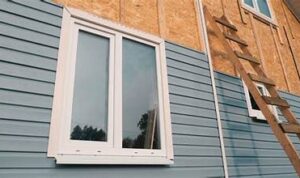Delving into the realm of exterior stucco siding unveils a world of possibilities and creativity. From its origins to modern applications, this versatile material offers a unique blend of functionality and aesthetics that can transform any building facade.
As we journey through the intricacies of exterior stucco siding, we uncover its defining characteristics and practical benefits that make it a popular choice among homeowners and architects alike.
Introduction to Exterior Stucco Siding
Exterior stucco siding is a popular choice for covering the exterior walls of buildings. It is a durable and versatile material that can enhance the appearance and protection of a structure.
Common Materials Used in Stucco Siding
- Portland cement
- Sand
- Water
- Lime
Benefits of Using Stucco Siding
- Weather-resistant: Stucco siding can withstand various weather conditions, including rain, wind, and sunlight.
- Durable: Stucco is a long-lasting material that does not require frequent maintenance or replacement.
- Energy-efficient: Stucco can help regulate indoor temperatures, reducing heating and cooling costs.
- Customizable: Stucco can be tinted to different colors and textures, allowing for a personalized look.
Installation of Exterior Stucco Siding
When it comes to installing exterior stucco siding, following a step-by-step guide is crucial to ensure a successful and long-lasting finish on your home. Proper preparation and the right tools are essential for a smooth installation process.
Step-by-Step Guide on How to Install Stucco Siding
Before starting the installation process, make sure to clean and prepare the surface where the stucco will be applied. Repair any cracks or damage to ensure a smooth and even finish. Here is a step-by-step guide to help you through the installation process:
- Apply a moisture barrier: Start by applying a moisture barrier to protect your home from water damage.
- Install metal lath: Secure metal lath to the surface using nails or screws, ensuring it is properly attached and provides a sturdy base for the stucco.
- Mix stucco: Follow the manufacturer's instructions to mix the stucco properly, achieving the right consistency for application.
- Apply the scratch coat: Spread the scratch coat evenly over the metal lath, creating a rough texture for the next coats to adhere to.
- Apply the brown coat: Once the scratch coat has set, apply the brown coat, smoothing it out for a uniform appearance.
- Apply the finish coat: Finally, apply the finish coat of stucco, using a trowel to create the desired texture and finish.
- Cure the stucco: Allow the stucco to cure and dry completely before painting or sealing it for added protection.
Tools and Equipment Needed for Stucco Siding Installation
Having the right tools and equipment is essential for a successful stucco siding installation. Here are some of the tools you will need:
- Trowel: Used for applying and smoothing out the stucco.
- Metal lath: Provides a base for the stucco to adhere to.
- Mixing tools: Such as a drill with a mixer attachment for mixing the stucco.
- Buckets: For mixing and holding the stucco mixture.
- Protective gear: Including gloves, safety glasses, and a mask to protect yourself during the installation process.
Importance of Proper Preparation Before Installing Stucco Siding
Proper preparation before installing stucco siding is crucial for a successful and long-lasting finish. Cleaning the surface, repairing any damage, and applying a moisture barrier are essential steps to ensure the stucco adheres properly and provides the desired look and protection for your home.
Maintenance of Exterior Stucco Siding
Regular maintenance is crucial to ensure the longevity and appearance of exterior stucco siding. By following some simple steps, you can keep your stucco siding looking great for years to come.
Regular Maintenance Tasks
- Inspect the siding annually for any cracks, chips, or damage. Address any issues promptly to prevent further deterioration.
- Clean the stucco siding at least once a year using a mild detergent and water solution. Avoid using abrasive cleaners that can damage the stucco surface.
- Trim vegetation around the siding to prevent moisture buildup and potential damage from plants touching the stucco.
- Check the caulking around windows, doors, and other openings in the siding. Replace any worn-out caulking to maintain a watertight seal.
Cleaning Stucco Siding
When cleaning stucco siding, it's essential to use the right tools and techniques to avoid damaging the surface.
- Mix a solution of mild detergent and water in a bucket.
- Using a soft-bristled brush or a cloth, gently scrub the stucco surface with the detergent solution.
- Rinse the siding thoroughly with clean water to remove any soap residue.
- Avoid using pressure washers on stucco siding, as the high pressure can cause damage to the stucco.
Repairing Cracks or Damage
Cracks or damage in stucco siding should be repaired promptly to prevent moisture infiltration and further deterioration.
- Clean the damaged area with a brush to remove any loose debris or dirt.
- Fill the crack or damaged area with a stucco patching compound using a putty knife, following the manufacturer's instructions.
- Smooth out the patched area with the putty knife and allow it to dry completely.
- Once the patch is dry, you can paint over it to match the color of the existing stucco siding.
Design Options for Exterior Stucco Siding
When it comes to designing your exterior stucco siding, there are various textures, finishes, colors, and architectural details to consider. These design options can truly enhance the overall look of your home.
Textures and Finishes
- Smooth Finish: A classic and modern look that provides a sleek appearance to your home.
- Swirl Finish: Adds a touch of elegance with a subtle swirl pattern that creates visual interest.
- Spanish Lace Finish: Offers a textured finish resembling lace, providing a unique and rustic look.
Popular Color Choices
- Earth Tones: Shades of brown, beige, and gray are popular choices for a natural and timeless look.
- White: A clean and crisp option that can make your home appear larger and more inviting.
- Warm Neutrals: Colors like taupe and cream create a cozy and welcoming feel to your home.
Incorporating Architectural Details
Architectural details can be added to your stucco siding to enhance the overall design of your home. Consider adding decorative trim, quoins, or molding to create a custom look. You can also incorporate architectural elements like arches, columns, or keystones for a more dramatic effect.
Closing Notes
In conclusion, exterior stucco siding stands as a testament to the marriage of style and durability in architectural design. Whether you seek a classic look or a contemporary feel, stucco siding offers a versatile canvas for your creative vision. Embrace the charm and resilience of stucco siding to elevate the exterior appeal of your space with timeless elegance.
FAQ Summary
What are the common materials used in stucco siding?
Common materials used in stucco siding include Portland cement, sand, lime, and water. These ingredients are mixed to create a durable and weather-resistant finish for exterior walls.
How do you clean stucco siding effectively?
To clean stucco siding, use a mixture of mild detergent and water. Gently scrub the surface with a soft-bristle brush, then rinse thoroughly with water. Avoid using high-pressure washers to prevent damage to the stucco.
What design options are available for exterior stucco siding?
Design options for stucco siding include various textures like smooth, rough, or patterned finishes. Color choices range from earthy tones to vibrant hues, allowing for customization to suit different architectural styles.
How to repair cracks or damage in stucco siding?
To repair cracks in stucco siding, clean the damaged area, apply a stucco patching compound, and smoothen the surface. For larger damage, consult a professional to ensure proper repairs and maintenance.







